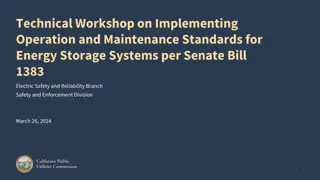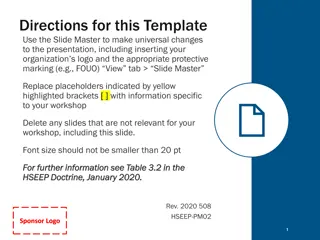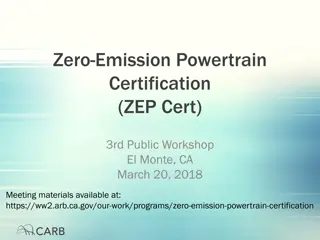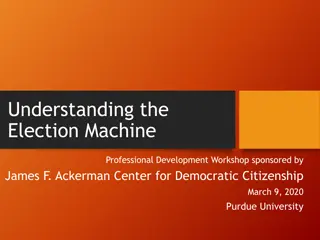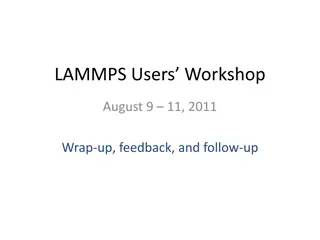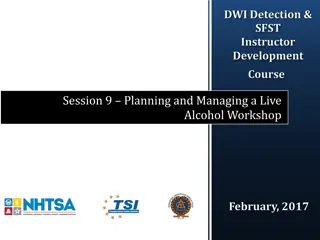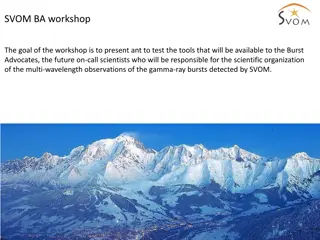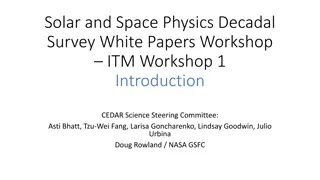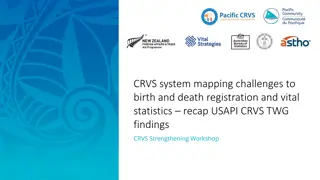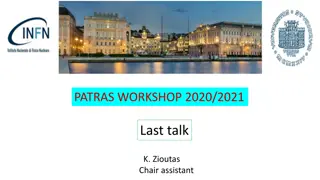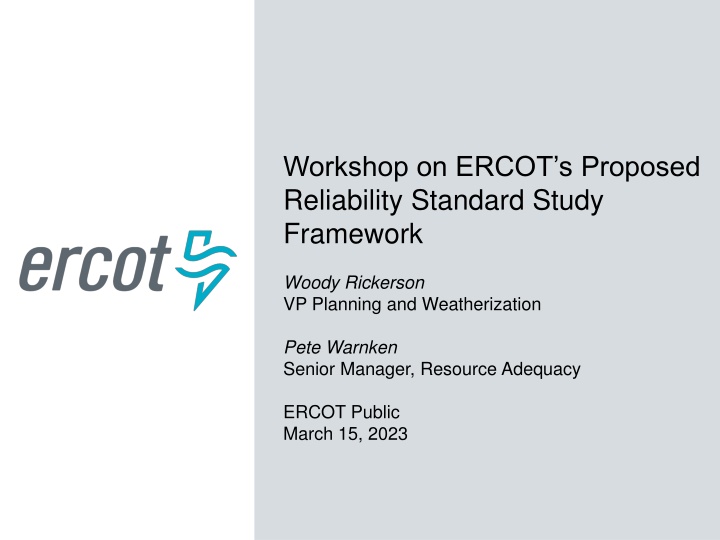
ERCOT Proposed Reliability Standard Study Framework Overview
Explore ERCOT's proposed reliability standard study framework, key takeaways, analysis process, and current study work details. Learn about the metrics, modeling tools, and scenarios used to ensure grid reliability and adequacy in Texas. Stay informed on the latest developments and recommendations shaping ERCOT's reliability standards.
Download Presentation

Please find below an Image/Link to download the presentation.
The content on the website is provided AS IS for your information and personal use only. It may not be sold, licensed, or shared on other websites without obtaining consent from the author. If you encounter any issues during the download, it is possible that the publisher has removed the file from their server.
You are allowed to download the files provided on this website for personal or commercial use, subject to the condition that they are used lawfully. All files are the property of their respective owners.
The content on the website is provided AS IS for your information and personal use only. It may not be sold, licensed, or shared on other websites without obtaining consent from the author.
E N D
Presentation Transcript
Workshop on ERCOTs Proposed Reliability Standard Study Framework Woody Rickerson VP Planning and Weatherization Pete Warnken Senior Manager, Resource Adequacy ERCOT Public March 15, 2023
Reliability Standard Study Process Key Takeaways: 1. Senate Bill 3 mandated the creation of an ERCOT Reliability Standard by the Public Utility Commission. 2. The Public Utility Commission created a Project (#54584) to facilitate that work, and issued a list of stakeholder questions on March 7, 2023. 3. A memo from Commissioner McAdams has requested ERCOT to work with PUC staff and Market Participants to begin the analysis. 4. ERCOT will use the Strategic Energy & Risk Valuation (SERVM) model for the study. 5. ERCOT presented a proposed study framework to its Board Members; the purpose of this workshop is to present, and solicit comments on, the study framework. 6. ERCOT is recommending a standard for study defined by three probabilistic metrics that cover the dimensions of loss-of-load events and addresses both average reliability and extreme event avoidance: 1. Limit on the magnitude of any single loss of load event 2. Limit the frequency of loss of load events 3. Limit on the duration of any single loss of load event 2 Item 7.1 ERCOT Public
Proposed Reliability Standard Analysis Process Proposed Study Metrics (Magnitude) Maximum load that can be rotated for any event should not exceed x% of peak (~x MW for today) Recommendation for metrics to be used by ERCOT for study (Frequency) Load Shed events for generator inadequacy should not occur more than once in x years 2026 assessment using different metric criteria; a combination of criteria is a Scenario (Duration) Any Load Shed event should not last for more than x hours. Determine the Generation Portfolio needed to avoid exceeding the metric criteria defined for each Scenario Multiple Scenarios to capture incremental production cost and reliability impacts of metric criteria changes Corresponding Market incentives needed to attract new generation to meet new standard Item 7.1 ERCOT Public 3
Current Study Work and Modeling Details SERVM is a probabilistic Monte Carlo simulation tool, used by ERCOT for reserve margins and NERC probabilistic loss-of-load studies since 2014, that produces a distribution of expected reliability events and their costs based on many independent hourly chronological simulations (or trials). ERCOT began training to enable staff to perform resource reliability studies previously performed by Astrape Consulting. The current phase of work consists of updating the SERVM model: Latest ERCOT load forecast, November CDR resources, and fuel price forecasts Include ERCOT Contingency Reserve Service and update Load Resources Coding to implement new metric definitions (extreme event limits) Address expected impact of weatherization standards Conduct test model runs to assess reasonability of results The Scenario resource portfolios will reflect new generation that is already expected to be built, likely retirements, and incremental levels of new dispatchable generation needed to meet the different level of reliability defined for each Scenario. Scenario outputs will be used to compare: Incremental amounts of additional dispatchable resources Overall production cost Cost to the Market Item 7.1 ERCOT Public 4
Next Steps 1. ERCOT anticipates commissioning a study to determine the Value of Lost Load (VOLL); decisions on the study scope and timeline are expected to be made at the March 23 PUC Open Meeting. 2. ERCOT is engaging Market Participants and PUC staff for input concerning the metrics used for the Reliability Standard study. 3. ERCOT will present a final proposed study framework to the PUCT and stakeholders: Metrics selected Scenarios defined for the study Metric criteria selected for each Scenario 4. ERCOT will start the Scenario analysis upon receiving direction from the PUCT. 5. An update on the progress will be made at appropriate stakeholder meetings, as well as the April and June ERCOT Board Meetings. 5 Item 7.1 ERCOT Public
Reliability Metrics / Criteria Used in Other Jurisdictions Hawaii: ERM is the Energy Reserve Margin, defined as the percentage of system load in which the system capacity must exceed the system load in each hour. Item 7.1 ERCOT Public 6
Reliability Metrics / Criteria Used in Other Jurisdictions Australia/New Zealand: WEM/WCM (winter energy margin/winter capacity margin). Item 7.1 ERCOT Public 7
Reliability Metrics / Criteria Used in Other Jurisdictions Countries with multiple metrics: oBelgium LOLH, LOLE95 oSpain PRM, LOLE oSouth Africa EUE, Capacity Factor exceedance for backup capacity Item 7.1 ERCOT Public 8
Supplemental Item 7.1 ERCOT Public
Loss-of-Load Reliability Metric Definitions A LOL event is defined as an hour during which firm load exceeds available generation capacity. A LOL day is defined as a day during which there is at least one LOL event; note that a day with one LOL event is equivalent to a day with two or more LOL events. The table below provides descriptions and calculation examples of the key probabilistic Reliability Standard metrics that should be considered by the Commission. For the measure calculation examples, it is assumed that there are 100 Monte Carlo simulation trials conducted for a given forecast year, and each trial has the same probability of occurrence, which is 1% (0.01). Measure Definition LOL Attribute of Interest Duration (number of hours) Calculation Example The expected number of LOL events for a given period. Alternatively, LOLH is the expected combined duration of LOL events for a given period. The expected number of LOL days for a given period. There are 10 trials that had 2 LOL events, and 2 trials that had 4 hours of LOL. The remaining 88 trials had no LOL events: LOLH = (10 trials x 2 hours/year x 0.01) + (2 trials x 4 hours/year x 0.01) = 0.2 + 0.08 = 0.28 hours/year Loss of Load Hours (LOLH) Frequency (number of days) There are 6 trials that had one day with a single LOL event, and 4 trials that had two days with two LOL events during each day. The remaining 90 trials had no LOL events: LOLE = (6 trials x 1 day/year x 0.01) + (4 trials x 2 days/year x 0.01) = 0.06 + 0.08 = 0.14 days/year Loss of Load Expectati on (LOLE) Note that the conventional definition of LOLE does not distinguish between a day with a single LOL event and a day with multiple LOL events. There is one trial with 2,500 MWh of unserved energy and one trial with 1,000 MWh of unserved energy. The remaining 98 trials had no LOL events: EUE = (1 trial x 2,500 MWh/year x 0.01) + (1 trial x 1,000 MWh/year x 0.01) = 25 + 10 = 35 MWh/year The expected total magnitude (in MWh) of LOL events for a given period. A variant, Normalized EUE (NEUE), is EUE divided by the total annual energy. Size (MWh) Expected Unserved Energy (EUE) Item 7.1 ERCOT Public 10
Loss-of-Load Reliability Metric Definitions Measure Definition LOL Attribute of Interest Likelihood of occurrence (probability) Calculation Example The probability that a LOL event will occur over a given period. For the winter period, there are 25 trials that had a total of 120 LOL days. The remaining 75 trials had no LOL days: LOLP = 120 / (90 days x 100 trials) = 1.3% Loss of Load Probability (LOLP) Item 7.1 ERCOT Public 11


